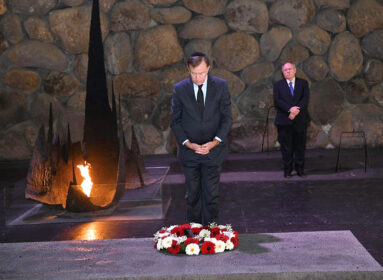Jewish Historical Society of Greater Hartford looks back over four decades
Big projects can often start small. Case in point: The Jewish Historical Society of Greater Hartford (JHSGH) began as a file cabinet in a closet on the third floor of the old Jewish Federation building on Bloomfield Avenue.
Four decades later, the Jewish Historical Society of Greater Hartford boasts many file cabinets, extensive archives, several publications and exhibitions, and designated office space in the Harry and Jeanette Weinberg Community Services Building on the Zachs Campus in West Hartford.
On Sunday, Oct. 30, the Society will celebrate its 40th anniversary with a gala dinner and program at Beth El Temple in West Hartford.
The little office was set up in 1971, three years after the Jewish Museum of New York had sent its traveling exhibit, “Portals to America,” to be displayed at the Jewish Community Center of Greater Hartford. Members of the JCC’s Jewish Cultural Committee, who helped put the show together, were inspired to chronicle the Jewish history of Hartford. They hired Edith Cooper, a retired librarian, to organize the fledgling archives.

A June 1971 photo of some of the Society’s incorporators includes (standing, left to right) Henry Lowengard, Elaine Lowengard, Joe Hurwitz, Rabbi Nathan Herschfield, Alex Hallenstein, Sadie Klau; (seated, left to right) Emma Cohen, Althea Silverman, Rabbi Morris Silverman and Judge Joseph E. Klau
Members of the new organization began by collecting interviews with older Jewish residents of the community and identifying a donated box of historical photographs. Its mission may have expanded to include extensive public programming, but it retains the vision of the founders: to collect and preserve the historical documents, photographs, and memorabilia that tell the story of the local Jewish community.
By 1982, Cooper was retiring and the organization wanted a professional to not only manage the archives but direct the operation as well. Marsha Lotstein applied. Lotstein had served on the board of the JCC of Greater Hartford since 1977, and was active in the children’s department and the senior adult department. When her daughter, an avid figure-skater, started getting more serious about her craft, Lotstein sought a part-time job in order to pay for lessons.
She consulted with Murry Shapiro, then director of the JCC. “I felt qualified for a position there, since my Master’s degree included two years of internship at Loeb Student Center at New York University, majoring in college union management,” Lotstein recalls. “Murry said that there was a better position for me, soon becoming available: the JHSGH was looking for a director and I should get my resume ready.”
Lotstein felt more qualified to work with people than with local history, but thought she could learn the ropes and applied anyway and was hired.
“I never could have imagined that the job could be so exciting, fulfilling and at times, challenging,” she says of the position she held for 23 years.

"My career began in my ‘new’ office, an 80-square-foot attic closet hidden away on the third floor of the former Federation building," said Marsha Lotstein, who was director of the Society for 23 years.
“My career began in my ‘new’ office, an 80-square-foot attic closet hidden away on the third floor of the former Federation building,” Lotstein says. “And in this closet was bequeathed to me a manual typewriter with red and black ribbon, one four-drawer file cabinet, about 25 archival boxes, and two shelves full of memorabilia. After one day of training, Edith wished me well and was off to enjoy her retirement. Needless to say, the first order of business was to beg Federation for one of their extra electric typewriters – which I then had for at least 10 years.”
Lotstein met the learning curve head on, attending workshops for beginning archivists offered by the Connecticut Historical Society, which also organized a group of professional archivists that met regularly. The workshop instructor, Llyn Conrad Kaimowitz, was hired in the early ‘90s as the JHSGH’s first professional archivist, through a grant from the Hartford Foundation for Public Giving.
In 1983, the Society founded a Jewish Sports Hall of Fame, the brainchild of member Morris Cohen. When the JCC completed a major expansion in 1991, the Society was given an office in the renovated building. “I believe that the move, 900 square feet of prime first-floor space, made the greatest impact on the Society in terms of its growth and success,” says Lotstein. “Accomplishing this move was also one of the highlights of my career. We now became a visible and viable organization.”

In 1983, the Society founded a Jewish Sports Hall of Fame. This is a collage of photos from Weaver High School in Hartford.
Over the next few years, the JHSGH was granted 501 (c)(3) status. With the financial support of the Jewish Community Foundation and other funders, the organization began publishing the JHSGH journal, “CT Jewish History,” and purchased a computer to digitize its archives.
The Society mounted some major exhibitions, through the financial support of the Connecticut Historical Society, the Connecticut Humanities Council, and the Connecticut Historical Commission (now the Connecticut Commission on Culture and Tourism), and the Hartford Foundation for Public Giving.
The Society published its first book in 1993, an architectural history of synagogues in Connecticut. Six years later, the organization created a traveling exhibit and book, “Witness to War,” chronicling the World War II-era experiences of Soviet Jews who had resettled in the Hartford area.
“During my tenure, I was privileged to work with the finest presidents our community has to offer and I am forever grateful to them for their confidence in me and for allowing me the opportunity to follow my visions for the Society,” Lotstein says. “These include: the late Moe Handler, the late Joe Hurwitz, Jerry Wagner, Leon Chameides, Seymour Saltzman, David Klau, Lea Rubenstein, and Art Nassau. I am grateful for the efforts of the Society’s very dedicated volunteers and the support of the membership. Their commitment is the foundation of all the Society has accomplished.”
“I must say that the JHSGH could not have been established and grown without the support of the JCC of Greater Hartford (now the Mandell JCC) and the Jewish Federation of Greater Hartford,” Lotstein says. “Their cooperation and backing were critical to our survival.”
Lotstein retired in 2004, and Estelle Kafer took over as executive director of the JHSGH. Kafer shifted the organization’s attention outward into the community.
“Marsha was instrumental in laying the foundation,” she says. “In the beginning, the founders collected a wonderful wealth of material, which she helped organize and archive, a huge undertaking during her tenure. When I came, I was very interested in taking the archives off the shelves and creating awareness of our wonderful history and not just collecting it. The JHSGH’s focus shifted to sharing that material through exhibitions, programs, publications, and lectures.”
In 2006, the organization moved to its current home. Two years later, it launched a two-year oral history project to document life in Hartford’s North End, resulting in two books. In the summer of 2010, the Society organized a trip to explore Jewish life in Eastern Europe before and after World War II, led by Rabbi David Small of The Emanuel Synagogue in West Hartford and Trinity College professor Sam Kassow.
This year, the Society teamed up with the Connecticut Historical Commission to document the history of Connecticut’s Jewish farming community.
Among the major projects in development, the JHSGH is designing a professionally researched and guided bus tour of the institutions and landmarks important to the immigrant groups that have settled in Harford, with a special emphasis on Jewish immigrants. The tour will highlight the various neighborhoods that were often the immigrants’ “first stop,” and use historical photos to recreate buildings or areas no longer in existence.
“I am so proud to be serving as president of the JHSGH during this tremendously exciting year of our 40th anniversary, and to be enjoying so many ‘trips down memory lane,” says JHSGH President Barbara Gordon. “Growing up in Hartford was the most wonderful way to spend our early years, when the biggest problem we faced was what kind of ice cream to get from the Good Humor truck. The friendships we made were lasting. Life was simple, yet so very satisfying.”’
And it is just those memories that Gordon believes must be preserved. Which is where the Society comes in.
“The JHSGH is serving an incredibly important role by perpetuating our memories and bringing them to life with so many exciting activities and programs. I am grateful to my immediate predecessor, Elliot Pollack, and those who served as president in the past, as well as to all of our staff, volunteers and members. May the JHSGH continue to thrive as it brings us the memories we all cherish.”
Lotstein agrees.
“For the Jewish community to survive,” she notes, “we must have a collective memory and understand where we have come from so that we may plan for our future. As the foundation of the Jewish community, it is critical for the JHSGH to grow and have adequate funding to create programs for younger generations, for day schools, secular schools and synagogues and to reach out to a Jewish and general population.”
The Oct. 30 program begins at 5 p.m., led by Master of Ceremonies Gerry Brooks, news anchor of NBC Connecticut. Highlights include a short film history of the Society, a new exhibit on the life of lightweight boxing champion and Hartford native Louis “Kid” Kaplan, and entertainment by Magevet, Yale University’s Jewish a capella singers. For more information contact Bea Brodie at (860) 727-6170 or bbrodie@jewishhartford.org.







 Southern New England Jewish Ledger
Southern New England Jewish Ledger

















